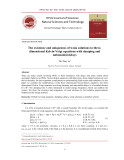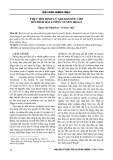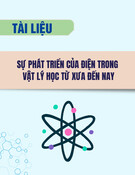
Current Chemistry Letters 6 (2017) 177–186
Contents lists available at GrowingScience
Current Chemistry Letters
homepage: www.GrowingScience.com
Quantum mechanical and electrochemical investigations on corrosion inhibition
properties of novel heterocyclic Schiff bases
Nimmy Kuriakose, K. Joby Thomas*, Vinod P. Raphael and C. Sini Varghese
Research Division, Department of Chemistry, St.Thomas’ College (University of Calicut) Thrissur, Kerala, India
C H R O N I C L E A B S T R A C T
Article history:
Received January 2, 2017
Received in revised form
March 1, 2017
Accepted April 21, 2017
Available online
April 22, 2017
The corrosion inhibition efficiencies of two novel Schiff bases, namely (E)-3-[thiophen-2-
ylmethyleneamino]benzoic acid (T2YMABA) and (E)-4-(5-[(2-phenylhydrazono)
methyl]thiophen-2-yl)benzoic acid (PHMT2YBA) on mild steel (MS) in 1.0M HCl solution
has been investigated and compared using electrochemical impedance spectroscopy and
potentiodynamic polarization analysis. The Schiff bases exhibited very good corrosion
inhibitions on mild steel in 1.0M HCl medium and the inhibition efficiency increased with the
increase in concentration of the inhibitor. Polarization studies revealed that T2YMABA acted
as a mixed type inhibitor whereas PHMT2YBA molecules acted as anodic inhibitor.
© 2017 Growing Science Ltd. All rights reserved.
Keywords:
Corrosion inhibitors
Mild Steel
Schiff base
Electrochemical impedance
Polarization studies
1. Introduction
Nitrogen containing organic compounds exhibit excellent corrosion inhibition characteristics in
acid medium. The presence of hetero atoms makes these inhibitors environmental friendly due to high
chemical activity and low toxicity 1-3. Despite the large numbers of organic compounds, several Schiff
bases were considered as good corrosion inhibitors. The presence of C=N- group and electronegative
N, S or O atoms in the molecule give remarkable corrosion inhibition properties4-6. The specific
interaction developed between the functional groups and the metal surface adds to the inhibition
capacity of these molecules. Corrosion commonly occurs at metal surfaces in the presence of oxygen
and moisture, involving electrochemical reactions7,8. The application of Schiff bases as an effective
corrosion inhibitor is mainly based on their ability to form a monolayer on the surface of the corroding
material. Electrochemical investigations can be employed to study the corrosion behaviour of metals
and mechanism of inhibition of these Schiff bases9-11.
The present investigation was undertaken to examine the corrosion inhibition behaviours of two
novel heterocyclic Schiff bases T2YMABA and PHMT2YBA. The anticorrosive activities of these
compounds were evaluated by electrochemical impedance spectroscopy (EIS) and potentiodynamic
* Corresponding author. Tel.: +919847177695
E-mail address: drjobythomask@gmail.com (K. J. Thomas)
© 2017 Growing Science Ltd. All rights reserved.
doi: 10.5267/j.ccl.2017.6.001

178
polarization analysis. Quantum chemical studies were also conducted to study the corrosion inhibition
response of these organic molecules which can be correlated with the energy of frontier molecular
orbitals12-14.
2. Results and discussions
2.1 Quantum chemical calculations
The corrosion inhibitive properties of the inhibitor molecules can be well studied by analysing the
energy levels of frontier molecular orbitals. The interaction between the vacant d orbitals of atoms on
the Iron surface and the filled molecular orbitals of the inhibitor molecules can be considered as a
donor-acceptor type according to the HSAB concept. This interaction plays the prominent role in the
prevention of metallic corrosion. A strong binding between the inhibitor molecules and the metal
surface is indicated by the larger value of EHOMO. The energy difference between the HOMO and
LUMO (∆E) should be the lowest in that case15. GAMMES software and DFT method are employed
for the optimization of geometry of molecules and quantum chemical calculations. A combination of
Beck’s three parameter exchange functional and Lee–Yang–Parr nonlocal correlation functional
(B3LYP) was used in DFT calculations16. Quantum mechanical parameters like EHOMO, ELUMO and ∆E
for the studied inhibitors are given in Table 1. HSAB parameters like chemical hardness (η) and
electronegativity (χ) of the molecules were calculated by the following equations17,
χ ≈ -1/2 (EHOMO + ELUMO ),
(1)
η ≈ 1/2 (EHOMO - ELUMO ).
(2)
The EHOMO value of the PHMT2YBA molecule was found to be higher among the two. Since the
energy separation between HOMO and LUMO was also lower for PHMT2YBA than T2YMABA, it
can be inferred that PHMT2YBA has a better inhibition activity than the other. Lower energy is
required to render electrons from HOMO of PHMT2YBA to the vacant d-orbitals of Fe. The
probability of acceptance of electrons from the metal surface to the LUMO of lowest energy of the
inhibitor is the greatest. The number of electrons (ΔN) transferred from donor to acceptor molecules
are calculated from the quantum chemical parameters. As an approximation, the chemical hardness of
Fe bulk metal is assumed as zero and the approximate electronegativity of bulk Fe is taken as 7eV. The
approximate number of electron transferred from the inhibitor molecule to the Fe atoms is calculated
by the following equation,
ΔN = χ𝐹𝐹𝐹𝐹−χ𝑖𝑖𝑖𝑖ℎ𝑖𝑖𝑖𝑖
2(η𝐹𝐹𝐹𝐹+η𝑖𝑖𝑖𝑖ℎ𝑖𝑖𝑖𝑖)
.
(3)
It is evident that the number of electrons transferred from the inhibitor molecule to the acceptor atom
is greater for PHMY2BA, which suggests that this molecule make a strong coordinate type interaction
with the metal atoms. The HOMO and LUMO of the molecules are represented in the Fig. 1.

N. Kuriakoseet al. / Current Chemistry Letters 6 (2017)
179
Fig. 1. HOMO and LUMO of T2YMABA and PHMT2YBA
Table 1. Quantum chemical parameters of T2YMABA and PHMT2YBA
2.2. Electrochemical impedance spectroscopy
Fig. 3 and Fig. 4 represent the Nyquist and Bode plots of MS specimens in the presence and absence
of the inhibitors T2YMABA and PHMT2YBA in 1.0 M HCl. It is evident from the plots that the
impedance response of metal specimens showed a marked difference in the presence and absence of
the inhibitors. The capacitance loop intersects the real axis at higher and lower frequencies. At high
frequency end, the intercept corresponds to the solution resistance (Rs) and at lower frequency end,
corresponds to the sum of Rs and charge transfer resistance (Rct). The difference between the two values
gives Rct 18-20. The value of Rct is a measure of electron transfer across the exposed area of the metal
surface and it is inversely proportional to rate of corrosion21-23.
Impedance behavior can be well explained by pure electric models that could verify and enable to
calculate numerical values corresponding to the physical and chemical properties of electrochemical
system under examination. The simple equivalent circuit that fit to many electrochemical system
composed of a double layer capacitance, Rs and Rct24,25. To reduce the effects due to surface
irregularities of metal, constant phase element (CPE) is introduced into the circuit instead of a pure
double layer capacitance26 which gives more accurate fit as represented in Fig. 2. The impedance of
CPE can be expressed as
𝑍𝑍𝐶𝐶𝐶𝐶𝐶𝐶 =1
𝑌𝑌
0
(𝑗𝑗𝑗𝑗)𝑖𝑖 ,
(4)
where Y0 is the magnitude of CPE, n is the exponent (phase shift), ω is the angular frequency and j is
the imaginary unit. CPE may be resistance, capacitance and inductance depending upon the values of
n27. In all experiments the observed value of n ranges between 0.8 and 1.0, suggesting the capacitive
response of CPE.
The EIS parameters such as Rct, Rs and CPE and the calculated values of percentage of inhibition
(ηEIS%) of MS specimens are listed in Table 2. The Rct values are increased with increasing inhibitor
concentration. Decrease in capacitance values CPE with inhibitor concentration can be attributed to the
decrease in local dielectric constant and /or increase in the thickness of the electrical double layer. This
emphasis the action of inhibitor molecules by adsorption at the metal–solution interface28. The
percentage of inhibition (ηEIS %) showed a regular increase with increase in inhibitor concentration. A
maximum of 94.34% and 96.83% inhibition efficiencies were achieved at an inhibitor concentration of
1mM for T2YMABA and PHMT2YBA.
Molecule
EHOMO (eV)
ELUMO (eV)
∆E (eV)
χ
η
ΔN
T2YMABA
-4.0599
0.2258
4.2857
1.9171
2.1428
1.1860
PHMT2YBA
-3.4749
0.5306
4.0055
1.4722
2.0028
1.3801

180
Fig. 2. Equivalent circuit model
Table 2. Electrochemical impedance parameters in the presence and absence of Schiff base inhibitors
T2YMABA and PHMT2YBA in 1.0 M HCl
Inhibitors
C
Cdl
Rct
ηEIS%
0
95.8
16.4
-
T2YMABA
0.2
73.4
70.3
76.07
0.4
120
86.7
81.08
0.6
111
117
85.99
0.8
77.5
238
93.11
1.0
91.7
290
94.34
PHMT2YBA
0.2
79
68.9
76.19
0.4
113
79.6
79.39
0.6
63.7
174
90.57
0.8
75.6
176
90.68
1.0
69.6
317
96.83
2.3. Potentiodynamic polarization studies
Potentiodynamic polarization curves for the inhibitors T2YMABA and PHMT2YBA are shown in
Fig. 5 and Fig. 6, respectively. Polarization parameters like corrosion current densities (Icorr), corrosion
potential (Ecorr), cathodic Tafel slope (bc), anodic Tafel slope (ba), and inhibition efficiency (Ep) for MS
specimens are listed in Table 3.
Fig. 3. Nyquist and Bode plots in the presence and absence of T2YMABA in 1.0 M HCl
Fig. 4. Nyquist and Bode plots in the presence and absence of PHMT2YBA in 1.0 M HCl

N. Kuriakoseet al. / Current Chemistry Letters 6 (2017)
181
Fig. 5. Tafel and Linear polarization plots in the presence and absence of T2YMABA in 1.0 M HCl
Fig. 6. Tafel and Linear polarization plots in the presence and absence of PHMT2YBA in 1.0 M HCl
A prominent decrease in the corrosion current density (Icorr) was observed in the presence of
inhibitors. A lowest value of Icorr was noticed for the inhibitor solution of concentration 1mM which
exhibited a maximum inhibition efficiency of 94.07% and 96.62% for T2YMABA and PHMT2YBA
respectively. On evaluation of the Tafel and polarization curves, one can see that slope of the Tafel
lines in presence of inhibitor varied considerably compared to the Tafel lines of uninhibited solution.
The inhibitor can be regarded as mixed type inhibitors since the slopes of both Tafel lines are affected
considerably. If the anodic or cathodic slopes vary from the slope of the uninhibited solution, the
inhibitor can be treated as an anodic or cathodic type inhibitor7Since the value of ba changes appreciably
in the presence of inhibitors, it may be assumed that the inhibitor molecules are more adsorbed on
anodic sites. Generally if the shift of Ecorr is >85 with respect to Ecorr of uninhibited solution, the
inhibitor can be viewed as cathodic or anodic type29. For the inhibitor T2YMABA the cathodic slope
is slightly varied suggesting that these molecules are acting on both the cathode and anode and thus can
be regarded as a mixed type inhibitor. Whereas PHMT2YBA molecules acted as anodic inhibitor for
MS specimens in 1.0 M HCl30.
Table 3. Potentiodynamic polarization parameters in the presence and absence of Schiff base inhibitors
T2YMABA and PHMT2YBA in 1.0 M HCl
Inhibitor
Tafel Data
Linear polarization
data
C (mM)
-E
corr
(mV/SCE)
I
corr
(μA/cm
2
)
-b
c
(mV/dec)
b
a
(mV/dec)
ηpol% Rp(ohm) ηRp%
0
465
726
106
72
-
38
-
0.2
476
183
89
79
74.79
82
73.51
0.4
483
174
93
89
76.03
114
80.88
T2YMABA
0.6
475
111
90
68
84.71
152
85.66
0.8
479
49.2
89
79
93.22
313
93.04
1.0
487
40.4
86
76
94.44
367
94.07
0.2
501
173
83
74
76.17
86
74.79
0.4
500
131
81
91
81.96
125
82.62
PHMT2YBA
0.6
517
76
84
100
89.53
214
89.81
0.8
515
68
76
94
90.63
221
90.14
1.0
516
39
85
95
94.63
405
96.62




















![Bộ câu hỏi lý thuyết Vật lý đại cương 2 [chuẩn nhất/mới nhất]](https://cdn.tailieu.vn/images/document/thumbnail/2025/20251003/kimphuong1001/135x160/74511759476041.jpg)
![Bài giảng Vật lý đại cương Chương 4 Học viện Kỹ thuật mật mã [Chuẩn SEO]](https://cdn.tailieu.vn/images/document/thumbnail/2025/20250925/kimphuong1001/135x160/46461758790667.jpg)




